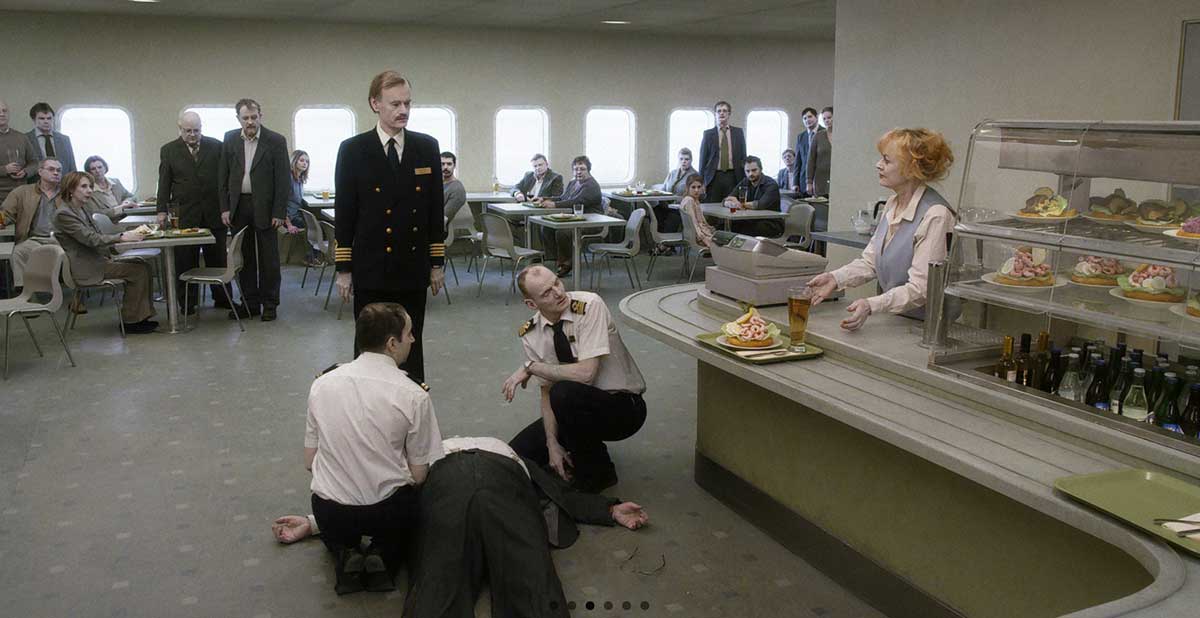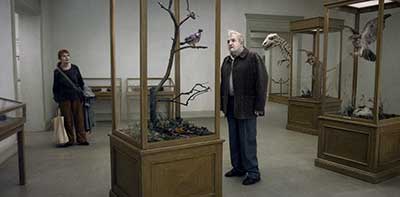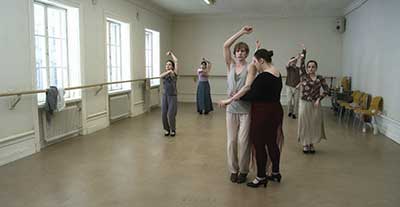A PIGEON SAT ON A BRANCH REFLECTING ON EXISTENCE

Release Date: 2014
by Peter Debruge, Variety
In a Venice Film Festival lineup full of cynicism, suicide and despair, who would expect the new Roy Andersson picture — “the final part of a trilogy on being a human being” — to be the most life-affirming? And yet, from its comic title to the wistful smile that accompanies its over-too-soon last shot, Andersson’s delightfully odd “A Pigeon Sat on a Branch Reflecting on Existence” finds the Swedish master of comic absurdity feeling downright generous, perched at a comfortable enough distance from this coterie of sad sacks and lonelyhearts to recognize the humor in such painful subjects as mortality, aging, unpaid debts and unrequited love.
Just last year, Ethan Hawke was quoted as referring to “Before Sunrise” and its two sequels as “the lowest-grossing trilogy in the history of motion pictures.” But even he probably hasn’t bought tickets to Andersson’s incomparable triptych — rapturously received by critics, though audiences have proven all but allergic to the first two films, which have cleared barely $100,000 so far in the U.S. The result of four years of rigorous planning and meticulous execution, “Pigeon” could fare slightly better than “Songs From the Second Floor” and “You, the Living” (both of which bowed at Cannes), but only just. At least arthouse programmers can now get creative, treating Andersson’s now-complete tragicomic opus, a decade and a half in the making, as the special event that it is.

“Pigeon” is by far the most accessible of the three films, offering a continuity throughline in the form of novelty salesmen Sam (Nils Westblom) and Jonathan (Holger Andersson), a comedic duo who’d be right at home in a Samuel Beckett or Tom Stoppard play. Here, the Laurel-and-Hardy-esque pair appear in nearly one-third of the film’s 37 fixed-camera compositions, a series of chuckle-inducing tableaux that clock in at just under three minutes apiece on average.
Each of these shots serves as a nearly self-contained comic vignette, like a cross between a “Where’s Waldo” cartoon and a Gregory Crewdson photograph, and the best way to approach them is as you might a large-canvas painting or a Jacques Tati film: Study the faces, soak up the details, allow the eye to wander and the mind to free-associate. Where other directors seek out exceptional moments, Andersson endeavors to capture the poetry of the mundane.
With the exception of one scene, in which twin girls blow bubbles from the balcony of a nondescript apartment building, and another that observes a plumpish new mom (Andersson loves his ladies with a little meat on their bones) cooing over her baby carriage, all the characters here are adults. Most of them have fewer days ahead of them than they do behind, but none seem to truly appreciate the gift of living. Andersson does, and he wants us to recognize it, too.
Right up front, the helmer presents three “meetings with death”: a husband who suffers a heart attack while struggling to uncork a wine bottle; an old lady convinced she can take her handbag to heaven; and a cruise-ship passenger who collapses at the lunch counter, having just paid for his meal (sorry, no refunds). More playful than his fellow Swede Ingmar Bergman, who famously challenged Death to a game of chess, Andersson recognizes that there’s no cheating mortality — though sometimes we can speed it along, like the suicidal CEO glimpsed later in the film. Best just to have a sense of humor about it.
Some critics have mistaken Andersson’s movies as “depressing” (while others have incorrectly labeled him a “commercials director,” failing to understand that he accepted those commissions to finance his painstaking feature ventures). “Droll” would be a better word for the artist’s attitude toward the washed-out blue and beige world he presents. His characters wear white face makeup to enhance their pallor, sleepwalking zombielike through their lives. Even the young couple seen necking on the beach appear to be doing so in slow-motion.
In the interval since his last film, Andersson has embraced hi-def digital cameras, which benefit his aesthetic enormously. Now, the helmer can ensure that even the far-distant background of every scene appears in sharp focus. Though the colors are dreary and the characters numb, compositionally speaking, there’s not a single dull frame in the entire film. Andersson thinks like a painter, following Edward Hopper’s example of enhancing loneliness by depicting it within a greater context. He shoots rooms at an angle, using perspective to direct our eyes toward the activity in adjacent rooms or on the other side of windows, instead of observing everything directly on axis, the way his similarly detail-oriented American namesake, Wes Anderson, insists on doing.
In “Pigeon,” people go about their business in the dreary little boxes of their lives, but they don’t behave like marionettes on strings, but almost like actors on a stage, occasionally turning to address the audience. “Today I feel kind,” announces a cheesemonger, while his wife gestures to the audience to let us know she thinks he’s crazy.

It’s unclear whether the shift to digital has allowed Andersson to manipulate his footage the way directors such as David Fincher and Ruben Ostlund do, using their locked-down cameras to make invisible nips and tucks. Regardless of the method, the film is a master class in comic timing, employing pacing and repetition with the skill of a practiced concert pianist.
Early on, outside a dance studio where the flamenco teacher gets a little too hands-on with one of her pupils, a lady janitor says into her phone, “I’m happy to hear you’re doing fine.” (Mobile phones are a rare nod to modern life in a film that appears to be set in a timeless retro past — and where King Charles XII and his infantry are prone to drop in unannounced, like characters in a Monty Python sketch.) The cleaning woman’s line becomes a hollow platitude echoed by many of the characters by film’s end, and yet, there’s something to be said for merely surviving in such an absurd world as this.
Down on their luck, Sam and Jonathan bill themselves as being in the “entertainment business,” selling plastic vampire teeth and a corny laughing device engineered to amuse. These two friends look like they haven’t smiled in a long, long time. Emerging as the most well-rounded character in the entire trilogy, Jonathan suffers from melancholy spells, culminating in a disturbing dream sequence, where colonial soldiers lead African slaves into a giant copper instrument that produces a beautiful sound as the people inside are being roasted alive. What a curious species are homo sapiens. Judging by the film, we wage war, torture animals and take advantage of one another, and yet, Andersson assures us, things could be worse. In the grand scheme of things, he’s happy to show we’re doing fine.
Cast & CreditsWriter & Director: Roy Andersson
Holger Andersson, Nils Westblom, Charlotta Larsson, Viktor Gyllenberg, Lotti Tornros, Jonas Gerholm, Ola Stensson, Oscar Salomonsson, Roger Olsen Likvern

